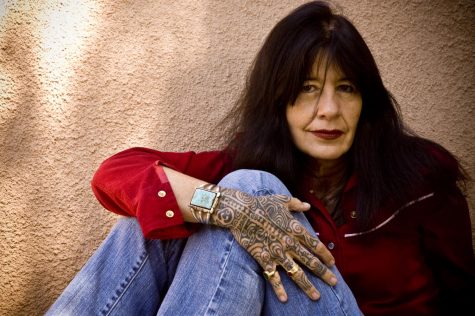Poet Laureate launches project to commemorate Indigenous communities
April 28, 2021

Every author has an origin story. In her latest project, U.S. Poet Laureate Joy Harjo created an interactive map so people can read about the lives of Indigenous poets.
The project is titled “Living Nations, Living Words” and will be officially released online May 4. Visitors can look at the map of the U.S. and click on one of 47 sun icons to hear Indigenous poets tell their stories.
On April 14, the Chicago Humanities Festival featured a virtual interview between Harjo, a member of the Muscogee (Creek) Nation and a chancellor of the Academy of American Poets, and award-winning poet Layli Long Soldier discussing the project.
Both Harjo and Long Soldier are Indigenous female poets who draw from their roots in their work.
Alison Cuddy, the artistic director for the Chicago Humanities Festival, said she was excited to include Harjo in the festival because Harjo is the only poet laureate to hold the position for three years in the U.S.
Cuddy said Harjo has various artistic talents, from singing to visual art, in addition to her poetry.
During the interview, Harjo said she started her mapping process by picturing a map that had no political boundaries or indications of different nations between North and Central America. She also envisioned the map having no English or Native names for landmarks like rivers and mountains.
Harjo began working on the map when she started her term in 2019 as the 23rd U.S. Poet Laureate.
“As the first Native Nations poet laureate, I was aware that Indigenous people of our country are often invisible or are not seen as human,” Harjo said in the introduction of her anthology “Living Nations, Living Words.” “Or we are known from false images and narratives.”
Cuddy said she appreciates Harjo’s willingness to use her experience as an Indigenous woman to advocate for marginalized groups.
“She chose to use her platform to create this experience that is available to all of us to really explore this poetry, and the range of voices and the experiences within it is phenomenal,” Cuddy said.
Harjo’s finalized work is a non-political map that shows all of North America connected as one land mass that features the real voices of people connected to the land by heritage.
Cuddy said mapping is part of the narrative, and the project restores all that has been erased by political maps—including Indigenous people and their cultural practices represented by different regions of North America.
“It’s not about states,” Cuddy said. “It’s a continuous land, and it identifies and locates different voices emerging from that land.”
The distinction between the sea foam-colored land and teal water is less recognizable with the color scheme, and the land has sun icons marking a poet in the region. Once the sun icon is clicked, a pop-up box shows the poet’s picture and biography with a link to a commentary and them reading their work aloud.
When one explores Harjo’s map on the Library of Congress website, they can find her reflective statement about the earliest Indigenous maps and her hope for the project.
“We mapped with weaving, baskets and in songs … I want this map to counter damaging false assumptions,” she said. “You will not find us fairly represented, if at all, in the cultural storytelling of America and nearly nonexistent in the American book of poetry.”
In addition to maps and groups of Indigenous people being erased, Harjo spoke at the festival about the loss of literary devices in indigenous languages such as Muscogee.
“[For the] Muscogee language people … we lost metaphor in our expression,” Harjo said. “I love how metaphor was incorporated in the descriptions on one of the oldest maps in existence, the Babylonian map,” Harjo said.
Cuddy said she believes poetry can connect people and help them conceptualize injustice in different ways. She compared Harjo’s efforts to restore hidden history to sociologist and author Eve Ewing’s book on the Chicago Riots, which have been swept under the rug in historical records.
“Whether we’re thinking about reparations [or] forced removal and the history of Indigenous communities with the U.S. government, [we’re] really trying to address these histories in a meaningful way,” Cuddy said. “I think Harjo is a part of that.”
The interview is available on YouTube, and a physical copy of Harjo’s “Living Nations, Living Words” anthology can be purchased online.







